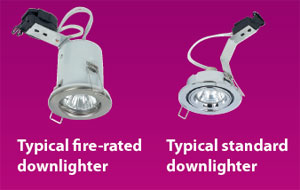Downlighters are one of the most modern and attractive ways to brighten up your home, but choosing the wrong downlighter, incorrectly installing it, or fitting the wrong lamp can pose a serious fire risk.
The guide below gives advice on how to prevent your downlighters from becoming a fire hazard (whether Fixed Ceiling Downlights or Adjustable Ceiling Downlights).
Read the first part below and the second part - Advice for Downlighter Safety(2): reflector types and checking your existing downlighters.
Advice for Downlighter Safety
The ceiling downlighters (ceiling recessed lights, whether adjustable downlights, fixed downlights, or Fire Rated Downlights) operate at mains voltage (230 Volts) or are powered via a transformer at extra-low voltage (12 Volts). Extra-low voltage (ELV) downlighters are often described as “low voltage” on product packaging. Downlighters may also be described as ‘Fire rated’. This means they have in-built fire protection that completely seals the downlighter in the event of fire in the room below, to prevent the spread of fire and smoke into other areas.
 For all downlighters installed into a ceiling, it is recommended to use of ‘fire rated’ downlighters fitted with ‘aluminium’ reflector lamps (see ‘Different lamp types’) to ensure fire and excessive heat are kept out of cavities. Also, where a downlighter is likely to be covered with thermal insulation in the cavity, it’s important to choose a downlighter that will operate safely under these conditions.
For all downlighters installed into a ceiling, it is recommended to use of ‘fire rated’ downlighters fitted with ‘aluminium’ reflector lamps (see ‘Different lamp types’) to ensure fire and excessive heat are kept out of cavities. Also, where a downlighter is likely to be covered with thermal insulation in the cavity, it’s important to choose a downlighter that will operate safely under these conditions.
Are You Thinking of Installing New Downlighters?
It is recommended that you use a registered electrician to install your downlighters and that you keep the manufacturer’s instructions in a safe place for future reference, such as when you need to replace a lamp.When fitting replacement lamps it is good to pay attention to:
- Read and follow the manufacturer’s instructions;
- Check the packaging and the downlighter for details of correct replacement lamps and do not exceed the maximum allowed wattage;
- Always switch off the electricity before changing a lamp;
- Don’t fit a dichroic (cool beam) reflector lamp unless the downlighter is specifically designed for use with that type of lamp. If in doubt, fit only aluminium reflector lamps (see ‘Reflector types’ in the next article);
- If the lampholder is damaged, scorched or corroded, do not fit the lamp, and seek advice from a registered electrician.




_ types of downlighters and tips for installing new downlighters.jpg)